Grantray-Lawrence/Krantz Films (1967), Buena Vista Home Entertainment (June 29, 2004), 6 discs, 1144 mins plus supplements, 1.33:1 original full frame ratio, Dolby Digital 2.0 Mono, Not Rated, Retail: $59.99
Storyboard:
Teenager Peter Parker is granted the proportional abilities of a spider after being bitten by a radioactive spider. Despite his newfound celebrity as the crime fighting Spider-Man, he still struggles with being accepted by the public and his peers, paying the rent, and generally catching any break at all.
The Sweatbox Review:
When I was eight years old, I was unaware that Spider-Man was a revolutionary character. I was not born into a world without Spider-Man, and did not know of a time when absolutely all heroes were perfect and devoid of problems. As far as I knew, the blue and red-costumed swinger was the prototypical superhero. He sure seemed cool to me, anyways. As far as I can recall, Spider-Man was the first cartoon show that I watched on Saturday mornings, while my weekdays had reruns of the live-action Batman and Adventures Of Superman. As much as I loved the exploits of Adam West and George Reeves, even as a wee lad I knew that Spidey was different. As outlandish as he was, there was a reality about his life— he was screwed by his boss, short of cash, distrusted by cops, and frustrated by women. Watching Spider-Man was a bit unsettling, since I could not rely on him always coming out on top, but I kind of liked that. I still like it.
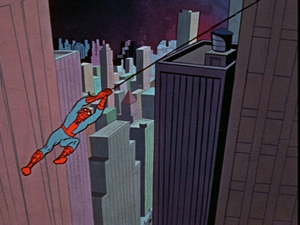
It was soon afterwards that I discovered Spider-Man comic books, and realized that they had their own intricate history that likely predated the cartoon show (which, of course, they did). It was not long, then, when I learned the name of Stan Lee, Spidey’s nominal creator; but it was a few more years before I learned that many of the storylines and character conventions were created or co-created by the original Spider-Man artist, Steve Ditko. As a pre-teen, I bought some used paperback reprints that presented the first 21 issues of Spidey’s stories from the early 1960s, and discovered that the tone of the cartoon show had been based quite faithfully on those early adventures.
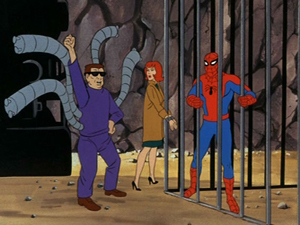
Spider-Man actually debuted in Amazing Fantasy #15, the last issue of an anthology title with nothing to lose, in 1962. Writer Stan Lee broke all the rules, making a superhero with foibles, to an even larger degree than he had done the prior year in Fantastic Four. Peter Parker was a nerdy high school kid with lots of brains and no social skills, who lucked into gaining extraordinary powers when bitten by a radioactive spider. He saw this as a chance to score some cash and fame, and he indulged in becoming selfish for the first time in his life. When he purposely allowed a crook to get away after committing a robbery, the crook later murdered Peter’s loving Uncle Ben. It was an absolutely brutal comeuppance. In a singular moment of insight, Peter truly learned that “with great power comes great responsibility”. From then on, he would use his spider-powers to combat criminals and protect the innocent.
A few months after his debut, Marvel Comics granted Peter his own series, Amazing Spider-Man, due to the character’s surprising popularity from his first appearance. In the months that followed, readers would find out that the powers and renewed dedication to do-gooding did not mean that Peter’s personal life would necessarily become better. The death of his uncle left his aunt broke, and Peter was still unable to find popularity at school, or even respect from either his peers or his new boss at the Daily Bugle. His fashion sense did not improve (did teenagers ever really wear powder blue suits to class?), and he lacked confidence when dealing with women. Indeed, life was a day-to-day struggle for Peter, not unlike everyone else on the planet.
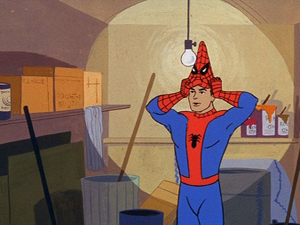
Ah, but at least he had those wondrous powers! He could climb walls, had super strength, and even developed a type of extra sense that warned him of potential danger. Additionally, he put his considerable brains to work and designed web fluid and shooters to simulate a spider’s web, which he used to swing between buildings or nab bad guys. He came up against one of comicdom’s greatest assortment of villains, often based on other animals— Rhino, Dr. Octopus, Vulture, Scorpion, Lizard, and Chameleon; but also other fiends like Electro, Green Goblin, and Sandman. Spidey was not always well-liked by the police or the average New Yorker, and Peter’s own boss J. Jonah Jameson used his newspaper to disparage Spider-Man, yet at least Peter knew that he was making a difference and using his talents in the best way he knew how.
And THAT is what made Spider-Man so appealing. The poor guy could not get a break, and in fact often slipped lower down life’s ladder the harder he tried; but he kept trying, just because he knew it was the right thing to do, and it would be worse to not try. He had abilities that made him capable of helping people, and recognized his responsibility to at least make an effort— and even if his own life did not improve due to his efforts, he was making a difference in the lives of those he helped. That eight-year old kid watching Spider-Man cartoons on Saturday mornings was taught an important lesson. We should use our talents, our gifts, for good deeds not because of personal gain or glory, but because it is the right thing to do. I saw that Peter still had trouble paying the rent or getting a date, but that lady was not killed or maimed by the Green Goblin, and that was really more important.
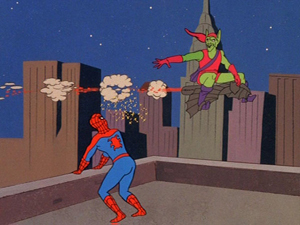
That is the Spider-Man who appeared in the first cartoon version back in 1967, prior to him meeting supermodel Mary Jane and settling down into married bliss. (In the cartoon, it is that other redhead, Betty Brant, who captures his attention.) Peter is a nice guy, but a bit of a schlep, while his alter ego is a wisecracking daredevil. Never has a mask provided a better release of inhibitions. This was also an era of fantastic uses for webbing, when it could be used to form such implausible devices as a shield, propeller, or a club. Unlike the movie version, this cartoon also showcases Peter Parker the scientist, using his powerful intellect when his powers just are not enough. To me, this always provided a strong appeal for the character— I loved that he could amplify his freakish powers by using his natural brainpower to create webshooters, tracers, and more.

The age of the comic book superhero on Saturday mornings had begun the previous year on ABC’s The New Adventures Of Superman, produced by Filmation, not to mention the syndicated Marvel Super Heroes Show. Spider-Man was originally produced in Toronto by Grantray-Lawrence Animation for ABC. Grantray-Lawrence was the same outfit that handled the Marvel Super Heroes Show. For Spidey’s next two seasons, the show’s production was moved to New York, where it was in the hands of Ralph Bakshi and Krantz Films. The voice work, however, continued to be done in Toronto, keeping the cast consistent. Spidey and his alter ego were voiced by Paul Soles, who was at the time the host for the CBC Radio show Take 30 (he had beaten out future ABC anchor Peter Jennings for the job in 1962). Soles was part of a troupe of voice actors directed by his cousin, Bernard “Bunny” Cowan. Cowan was a co-producer on Spider-Man, and also worked on the other Marvel Comics cartoons. The same voice troupe also did Rankin-Bass’s Rudolph The Red-Nosed Reindeer and the cartoon show Rocket Robin Hood.
The first season of Spider-Man had 20 episodes, generally two stories per show (although there were a couple of two-parters shown complete in that half-hour). The second season added the “harbor” title cards, and mostly had full-length stories, again with a couple of exceptions in its 19 episodes. Interestingly, Spidey’s origin story was told as the first episode of the second season, as it had not been created for the first season. The third season had 13 episodes, mixed between half- and full-length stories. This final season ended up being syndicated, only premiering in March 1970.
In general, the first season featured many of Spidey’s comic book adversaries and relatively down-to-earth superheroics. The second and third seasons, aside from some more classic bad guys, went off in more outlandish directions, with Spidey meeting people from underground, going back and forth in time, and traveling to other worlds and dimensions. It seems bizarre to have New York’s quintessential superhero battling giant lightning-wielding Vikings from another planet, but such are the charms of the latter seasons.
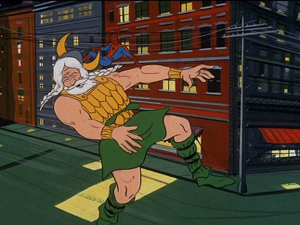
The change in story direction was mirrored by the look of the show as well. Backgrounds in the initial season were often simple. The sky was pure blue, the buildings were orange, etc. In the second season, the skies became purple and green, with black ink smeared all over creation. This was all due in more than one way to the switch to Krantz Films. Aside from using some different artists on Spidey, Krantz was simultaneously producing Rocket Robin Hood. Observant viewers could note that the backgrounds on Spidey’s show were being utilized from Robin’s show, which was an outer space adventure. In fact, one episode was totally recycled from a Rocket Robin Hood story, with Spidey inserted for Robin. Other Spidey episodes were clearly written to utilize existing science fiction-based art.
There are other indications of, shall we say, production savings in all seasons of the show. The same animation is reused over and over, notably the web-swinging cycles— the half-hour stories are notably padded with swing cycles. The animation is quite limited, with only individual body parts moving, or characters sliding across the screen. In some scenes, the bottom portion of Spider-Man’s mask is colored differently than the rest, as it the only part being animated while Spidey talks. Character design is also indicative of cost savings, as Spider-Man’s costume lacks webbing over the torso. (Also, and this may be more due to error, the spiders on the front and back of his costume are usually drawn with only six legs!) It may also be noted that the draftsmanship on the series was less than spectacular, barely a step above Super Friends in its ability to portray the human figure in a dynamic way.
Many would consider the moral tone of this and other superhero shows as simplistic, but for all the complexities of our modern world there is still such a thing as right and wrong. The villains in a superhero universe are easy to spot certainly, what with their pockmarked complexions and bizarre costumes, but these simple morality tales do manage to teach us how to confront the evil we see. And for pure fun, sentimental or otherwise, these shows cannot be beat!
This DVD set has all 52 half-hour shows of the three seasons, making this one of the more comprehensive DVD cartoon sets ever put out, and a boon to collectors as well as Marvel Comics fans. Whether you enjoy straightforward New York superhero adventure or trippy other-dimensional adventure, there is plenty to enjoy in these 52 classic episodes.
Is This Thing Loaded?
Advance publicity for this set touted a “written introduction” by Stan Lee, and this appears in the booklet that comes in the case. The discs themselves contain no extras that relate directly to the 1967 Spider-Man show.
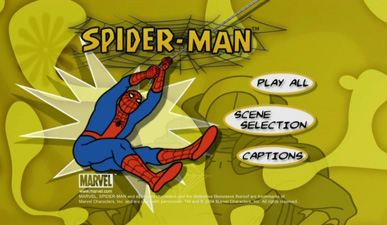
As always, however, Disney did place a number of Previews on Disc One. These include the Aladdin DVD, Spider-Man: The Venom Saga, Bionicle 2, and Spider-Man Vs. Doc Ock.
This is not really a bonus, but the animated menus are really SNAZZY, and the scene selections menus (each story is a “scene”) do show full video, which I always like to see.
Case Study:
I will give good marks to Disney for a spiffy looking package. The cardboard slipcase (eminently more removable than Warner’s Hanna-Barbera plastic slipcases) is smartly illustrated and utilizes a fine graphic sense. Inside is a book-style DVD case, with a red plastic tray for each disc. The only negative is that these trays are less sturdy than the ones that Warner Brothers uses for the similar packaging for their Babylon 5 and Smallville sets, and two of the trays in my case were broken in the mail. There is also the aforementioned booklet with Stan Lee’s introduction, episode listings, credits, and naturally the theme song’s lyrics. Spiffy.
Ink And Paint:
About a year ago, the word was out that current rights-owner Disney was putting up the dough to digitally restore the entire Spider-Man series. These remastered episodes are now on this DVD set, although with mixed results.
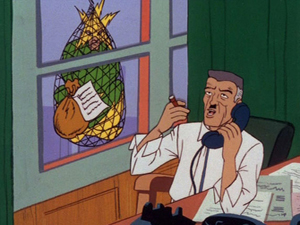
For the most part, the episodes look bright and sharp, better than I have ever seen them. As with other older cartoon series, one must expect a certain amount of smudges and cel dust to appear, but overall the image quality is very nice. Unfortunately, an unnecessary amount of edge enhancement was added, resulting in a variable amount of haloing around the edges of the drawings. The news becomes much worse on Disc 5, and to a lesser extent Disc 6. Several stories on the fifth disc look like they used unrestored prints. In particular, The Winged Thing and the next few stories look rather hideous, blurry and grainy to an extent that makes them painfully stick out from the superior video quality of the vast majority of the set. Please note that several of the episodes on Disc 5 do look as good as the previous discs. Disc 6 is better overall, except for Up From Nowhere looking just as bad as the worst from Disc 5.
The drop in quality on a few episodes is unfortunate, but well over 40 out of 52 ain’t too bad I suppose.
Scratch Tracks:
Naturally, this show is presented with a mono soundtrack (over two channels). The audio is consistently as good as it could be, with no hiss or significant distortion. Just don’t look for any directional effects or thundering bass.
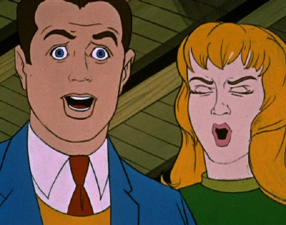
It is interesting to note that aside from the famous theme song, Spider-Man used only stock music. Still, considering the producers had access to a stock catalog, it is incredible that they relied on the same themes and cues so repetitively. Of course, this is the music we all associate with the show, and it was less noticeably repetitive when one only watched one show a week.
Final Cut:
Aside from some significant concerns about image quality on two of the discs and a lack of extras, this is a great set for superhero cartoon fans. You cannot get much more “classic” in relation to television cartoons than this show, and this set has every episode. The character of Spider-Man is a terrific role model for kids, and I still can find inspiration in him as an adult.
It is very promising to see such a set released, especially knowing that Disney also owns the rights to several other Marvel Comics shows. If this set is a successful seller, we will certainly be treated to more sets featuring our favorite comic book characters. I recommend that you support this release, and gleefully prepare for more to come.
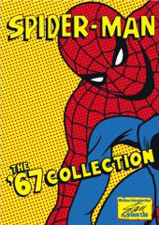 | ||
 |









